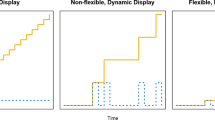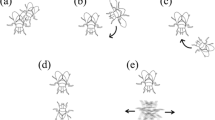Abstract
Research on male courtship behavior of moths has focused on documenting stereotyped sequences for successful copulation. We characterized successful male courtship behavior among 126 virgin mating pairs of Ostrinia nubilalis. Using Markov analysis, stereotypy indices, and a novel application of ecological network analysis, we found high variability in these sequences. Fifteen courtship behaviors were described and 96 behavioral transitions were observed, 39 of which occurred only once. The number of courtship bouts ranged from one to ten, the number of behavioral transitions ranged from four to 41, and the number of copulation attempts ranged from one to 29. Only 23% of males used a common, simple behavioral sequence. Females exhibited acceptance or rejection behaviors in 40% of the sequences, but these did not explain the high variability in male courtship sequences. About half of the transitions occurred non-randomly, and stereotypy was low. Network analysis revealed that the courtship sequences started and ended with stereotyped behaviors and the high variability occurred in the middle of the sequences. Whole system analysis showed that the courtship sequences were more variable than for optimal transfer of information. Overall, these results suggest that the sequence of behaviors may be less important than the occurrence of certain behavioral elements for successful mating.


Similar content being viewed by others
References
Andow DA, Stodola TJ (2003) European corn borer rearing manual. Retrieved from the University of Minnesota Digital Conservancy. http://hdl.handle.net/11299/174415. Accessed 27 Mar 2017
Baker TC, Carde RT (1979) Courtship behavior of the oriental fruit moth (Grapholitha molesta): experimental analysis and consideration of the role of sexual selection in the evolution of courtship pheromones in the Lepidoptera. Ann Entomol Soc Am 72:173–188
Birch MC, Lucas D, White PR (1989) The courtship behavior of the cabbage moth, Mamestra brassicae (Lepidoptera: Noctuidae), and the role of male hair-pencils. J Insect Behav 2:227–239
Burns EL, Teal PEA (1989) Response of male potato stem borer moths, Hydraecia micacea (Esper), to conspecific females and synthetic pheromone blends in the laboratory and field. J Chem Ecol 15:1365–1378
Castrovillo PJ, Carde RT (1980) Male codling moth (Laspeyresia pomonella) orientation to visual cues to the presence of pheromone and sequences of courtship behaviors. Ann Entomol Soc Am 73:100–105
Charlton RE, Carde RT (1990) Behavioral interactions in the courtship of Lymantria dispar (Lepidoptera: Lymantriidae). Ann Entomol Soc Am 83:89–96
Conner WE (1999) ‘Un chant d’appel amoureux’: acoustic communication in moths. J Exp Biol 202:1711–1723
Conner WE, Eisner T, Vander Meer RK, Guerrero A, Meinwald J (1981) Precopulatory sexual interaction in an arctiid moth (Utetheisa ornatrix): role of a pheromone derived from dietary alkaloids. Behav Ecol Sociobiol 9:227–235
Eiras AE (2000) Calling behaviour and evaluation of sex pheromone glands extract of Neoleucinodes elegantalis Guenée (Lepidoptera: Crambidae) in wind tunnel. Ann Soc Entomol Bras 29:453–460
Ellis PE, Brimacombe LC (1980) The mating behaviour of the Egyptian cotton leafworm moth, Spodoptera littoralis (Boisd.). Anim Behav 28:1239–1248
Fagen RM, Young DY (1978) Temporal patterns of behaviors: durations, intervals, latencies, and sequences. In: Colgan PW (ed) Quantitative ethology. Wiley, New York, pp 79–114
Fatzinger CW, Asher WC (1971) Mating behavior and evidence for a sex pheromone of Dioryctria abietella (Lepidoptera: Pyralidae (Phycitinae)). Ann Entomol Soc Am 64:612–620
Gelman DB, Hayes DK (1982) Methods and markers for synchronizing maturation of fifth-stage larvae and pupae of the European corn borer, Ostrinia nubilalis (Lepidoptera: Pyralidae). Ann Entomol Soc Am 75:485–493
Girling RD, Carde RT (2006) Analysis of the courtship behavior of the navel orangeworm, Amyelois transitella (Walker) (Lepidoptera: Pyralidae), with a commentary on methods for the analysis of sequences of behavioral transitions. J Insect Behav 19:497–520
Glover TJ, Tang XH, Roelofs WL (1987) Sex pheromone blend discrimination by male moths from E and Z strains of European corn borer. J Chem Ecol 18:143–151
Grant GG (1976) Female coyness and receptivity during courtship in Plodia interpunctella (Lepidoptera: Pyralidae). Can Entomol 108:975–979
Hannon BM (1973) The structure of ecosystems. J Theor Biol 41:535–546
Haynes KF, Birch MC (1984) Mate-locating and courtship behaviors of the artichoke plume moth, Platyptilia carduidactyla (Lepidoptera: Pterophoridae). Environ Entomol 13:399–406
Hou RF, Chen S-M (1988) Mating behavior of the rice leaf-folder, Cnaphalocrocis medinalis Guenée (Lepidoptera: Pyralidae). Appl Ent Zool 23:355–357
Johansson BG, Jones TM (2007) The role of chemical communication in mate choice. Biol Rev 82:265–289
Klun JA (1975) Insect sex pheromones: intraspecific pheromonal variability of Ostrinia nubilalis in North America and Europe. Environ Entomol 4:891–894
Klun JA, Chapman OL, Mattes KC, Wojtkowski PW, Beroza M, Sonnet PE (1973) Insect sex pheromones: minor amount of opposite geometrical isomer critical to attraction. Science 181:661–663
Kochansky J, Cardé RT, Liebherr J, Roelofs WL (1975) Sex pheromone of the European corn borer, Ostrinia nubilalis (Lepidoptera: Pyralidae), in New York. J Chem Ecol 1:225–231
Konno Y, Honda H, Matsumoto Y (1980) Observations on the mating behavior and bioassay for the sex pheromone of the yellow peach moth, Dichocrocis punctiferalis Guenée (Lepidoptera: Pyralidae). Appl Ent Zool 15:321–327
Lassance J-M, Löfstedt C (2009) Concerted evolution of male and female display traits in the European corn borer. Ostrinia nubilalis. BMC Biol 7:10
Leahy TC, Andow DA (1994) Egg weight, fecundity, and longevity are increased by adult feeding in Ostrinia nubilalis (Lepidoptera: Pyralidae). Ann Entomol Soc Am 87:342–349
Leontief W (1951) The structure of the American economy, 1919-1939, 2nd edn. Oxford University Press, New York
Mason CE, Rice ME, Calvin DD (1996) European corn borer ecology and management. North Central Region extension publication 327. Iowa State University, Ames
Meagher RL, Epsky ND, Cherry R (2007) Mating behavior and female-produced pheromone use in tropical sod webworm (Lepidoptera: Crambidae). Fla Entomol 90:304–308
Milonas PG, Andow DA (2010) Virgin male age and mating success in Ostrinia nubilalis (Lepidoptera: Crambidae). Anim Behav 79:509–514
Milonas PG, Farrell SL, Andow DA (2011) Experienced males have higher mating success than virgin males despite fitness costs to females. Behav Ecol Sociobiol 65:1249–1256
Nakano R, Ishikawa Y, Tatsuki S, Surlykke A, Skals N, Takanashi T (2006) Ultrasonic courtship song in the Asian corn borer moth, Ostrinia furnacalis. Naturwissenschaften 93:292–296
Phelan PL, Baker TC (1990) Comparative study of courtship in twelve phycitine moths (Lepidoptera: Pyralidae). J Insect Behav 3:303–326
Royer L, McNeil JN (1992) Evidence for a male sex pheromone in the European corn borer, Ostrinia nubilalis (Hübner) (Lepidoptera: Pyralidae). Can Entomol 124:113–116
Sanders CJ, Lucuik GSM (1992) Mating behavior of spruce budworm moths, Choristoneura fumiferana (Clem.) (Lepidoptera: Tortricidae). Can Entomol 124:273–286
Schlaepfer MA, McNeil JN (2000) Are virgin male lepidopterans more successful in mate acquisition than previously mated individuals? A study of the European corn borer, Ostrinia nubilalis (Lepidoptera: Pyralidae). Can J Zool 78:2045–2050
Szyrmer J, Ulanowicz RE (1987) Total flows in ecosystems. Ecol Model 35:123–136
Takanashi T, Nakano R, Surlykke A, Tatsuta H, Tabata J, Ishikawa Y, Skals N (2010) Variation in courtship ultrasounds of three Ostrinia moths with different sex pheromones. PLoS One 5(10):e13144
Teal PEA, McLaughlin JR, Tumlinson JH (1981) Analysis of the reproductive behavior of Heliothis virescens (F.) under laboratory conditions. Ann Entomol Soc Am 74:324–330
Ulanowicz RE (2009) Increasing entropy: heat death or perpetual harmonies? Int J Des Nat Ecodyn 42:83–96
Ulanowicz RE (2011) Quantitative methods for ecological network analysis and its application to coastal ecosystems. In: Wolanski E, McLusky D (eds) Treatise on estuarine and coastal science, vol 9. Academic Press, Waltham, pp 35–57
**ao W, Honda H, Matsuyama S (2011) Monoenyl hydrocarbons in female body wax of the yellow peach moth as synergists of aldehyde pheromone components. Appl Entomol Zool 46(2):239–246
**ao W, Matsuyama S, Ando T, Millar JG, Honda H (2012) Unsaturated cuticular hydrocarbons synergize responses to sex attractant pheromone in the yellow peach moth. Conogethes punctiferalis. J Chem Ecol 38(9):1143–1150
Acknowledgements
This research was funded in part by the US Department of Agriculture Regional Research Project NC205.
Author information
Authors and Affiliations
Corresponding author
Ethics declarations
The authors have no potential conflicts of interest. The research did not involve humans or animals requiring review or oversight and complies with all requirements related to research involving animals.
About this article
Cite this article
Farrell, S.L., Andow, D.A. Highly variable male courtship behavioral sequences in a crambid moth. J Ethol 35, 221–236 (2017). https://doi.org/10.1007/s10164-017-0513-0
Received:
Accepted:
Published:
Issue Date:
DOI: https://doi.org/10.1007/s10164-017-0513-0




